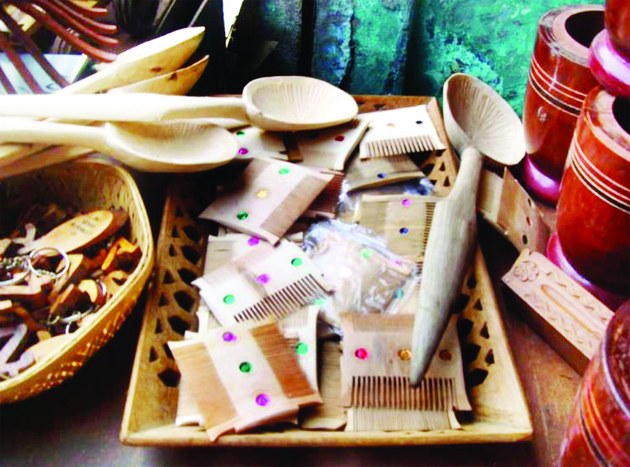Dr Zishan Ahmad Wani, Qamer Ridwan
Nestled within the serene landscapes of Rajouri, amid the breathtaking vistas of Jammu and Kashmir, a centuries-old tradition thrives, infusing life into wood and weaving a tapestry of heritage, culture, and nature. The art of Chikri woodcraft transcends not only economic sustenance but also embodies a way of life, a profound connection to the land, and a source of immense pride. Rooted in the wood of Himalayan Boxwood, locally known as Chikri, this craft stands as a remarkable testament to the harmonious interplay between craftsmanship and the natural world. Himalayan Boxwood is a small tree that reaches heights of up to 15 m with evergreen foliage. The plant is distributed to the North-Western Himalayan region, encompassing Jammu and Kashmir, Himachal Pradesh, Uttarakhand, Pakistan, Nepal, and Bhutan. Its preference for shaded habitats and aversion to direct sunlight contribute to its distinctive growth patterns. The wood is prized for its uniformity, durability, and elegant texture, for this unique quality it becomes an ideal medium for artisans. This innate beauty obviates the need for paint or polish, allowing the wood’s intrinsic charm to radiate through creations ranging from intricately carved toys to ornate decorations and photo frames. Boxwood sustains the whole cottage industry. Based on the socio-ecological surveys conducted by Wani et al., (at Baba Ghulam Shah Badshah University) in the region, it was observed that a variety of handicraft articles are being made from the wood of Himalayan Boxwood and are sold in the local market, especially in the market of Shahdara Sharief, which is a holy shrine of Baba Ghulam Shah Badshah.
Tourists and devotees are the main buyers of these handcrafted items. However, locals also prefer products made of chikri wood. These articles are considered blessings of the holy shrine; hence, boxwood products have a good market. A good section of the population at Shahdara Sharief is earning its livelihood by making or selling handmade articles made from wood. The economic value of this plant is assessed to be around 84,000 INR per household per year. However, it has been found that there is a continuous drop in the availability of raw materials and the prices paid for these wooden goods also remain almost stagnant. Through generations, local artisans in the Rajouri-Poonch region have nurtured this craft, passing down ancestral wisdom and techniques. Their dedication and expertise have fostered a cottage industry and infused vitality into the wood, breathing life into lifeless objects. Recently, this wood artistry was granted the prestigious Geographical Indication (GI) tag, an accolade resonating with the botanical splendor of Boxwood and the artistic prowess of local craftsmen.
This GI tag, signifying authenticity, honors these artisans’ devotion to their craft and their role in safeguarding this cultural legacy. Beyond its celebratory aspect, this recognition underscores the pressing need for conservation. The very existence of Himalayan Boxwood, the cornerstone of Chikri woodcraft, is imperiled by overexploitation, and necessitating the adoption of sustainable practices for its survival. A study titled ‘Buxus wallichiana L., a multipurpose Himalayan tree in peril’ by Shreekar Pant was also published in the International Journal of Biodiversity and Conservation in May 2011, underscores this threat and calls for responsible stewardship. A more recent study by Wani et al., predicted that only 19.2% of the total area of the Western and Northwestern Himalayas (Jammu and Kashmir, Ladakh, Himachal Pradesh, and Uttarakhand) is suitable for the growth of this plant, and even in Jammu and Kashmir, only a narrow belt of the Rajouri-Poonch region harbors suitable habitats for the Himalayan Boxwood. The threat faced by the species due to its restricted distribution to a small geographic range and highly specific ecological niche makes it vulnerable to stochastic events and human interference, which is alarming for the species’ existence. Hence, there is an urgent need to frame pertinent conservation and management policies for its habitat restoration and reintroduction of this species. Institutions and Universities in the region should join hands for thorough research on chikri wood (Himalayan Boxwood) and support plantation drives carried out by State Forest Departments. Further, awareness and capacity-building programs should be organized among locals for conservation and sustainable harvesting. Moreover, mass people participation is required for the long-term conservation of Boxwood.
The Geographical Indication (GI) tag signifies not a mere honor but it serves as a poignant reminder of the delicate equilibrium between tradition and nature, a pact that Rajouri must uphold. Amidst the elation of recognition, our responsibility to the environment and our heritage remains paramount. Urgent adoption of sustainable practices, prioritizing the preservation of ecological balance, is imperative. The GI tag is a compass, directing us not only towards a sustainable future but also enjoining us to safeguard the environment, bolster local economies, and nurture our cultural legacy. As we applaud the acknowledgment of Chikri woodcraft, we must reflect and pledge to uphold its legacy.
By embracing sustainable utilization and conservation, we ensure that future generations can revel in the allure of this art form. In a world often consumed by rapid progress, the GI-tagged recognition of Chikri woodcraft shines as a beacon of hope. It reminds us that even within our frenetic lives, the essence of our heritage can flourish, uniting us with our roots and enriching our lives through art, culture, and nature. Gazing towards the horizon, the GI tag stands as a symbol of optimism, guiding us towards a sustainable path where tradition flourishes harmoniously with nature.
Rajouri’s Chikri wood craft encapsulates the enchantment that emerges when art, culture, and botanical beauty converge.
(The authors are Research Scholars, Department of Botany, Baba Ghulam Shah Badshah University, Rajouri
Inputs by Dr. Shreekar Pant, who is Coordinator, Centre for Biodiversity Studies, School of Biosciences and Biotechnology, Baba Ghulam Shah Badshah University, Rajouri.)
Home Weekly specials Heritage Chikriwood craft of Rajouri A reverence for nature and tradition receives GI...


